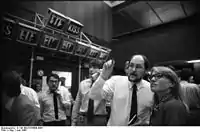Bond market index
A bond index or bond market index is a method of measuring the value of a section of the bond market. It is computed from the prices of selected bonds (typically a weighted average). It is a tool used by investors and financial managers to describe the market, and to compare the return on specific investments.

An index is a mathematical construct, so it may not be invested in directly. But many mutual funds and exchange-traded funds attempt to "track" an index (see index fund), and those funds that do not may be judged against those that do.
Types of indices
Bond indices can be categorized based on their broad characteristics, such as whether they are composed of government bonds, municipal bonds, corporate bonds, high-yield bonds, mortgage-backed securities, syndicated or leveraged loans, etc. They can also be classified based on their credit rating or maturity.
Bond indices tend to be total rate-of-return indices and are used mostly as such: to look at performance of a market over time. In addition to returns, bond indices generally also have yield, duration, and convexity, which is aggregated up from individual bonds.
Bond indices generally include more individual securities than stock market indices do, and are broader and more rule-based. This allows portfolio managers to predict which type of issues will be eligible for the index.
Weighting
Most bond indices are weighted by market capitalization. This results in the bums problem, in which less creditworthy issuers with a lot of outstanding debt constitute a larger part of the index than more creditworthy ones.[1]
Indices and passive investment management
Bond indices are harder to replicate compared to stock market indices due to the large number of issues. Usually, portfolio managers define suitable benchmarks for their portfolios, and use an existing index or create blends of indices based on their investment mandates. They then purchase a subset of the issues available in their benchmark, and they use the index as a measure of the market portfolio's return to compare their own portfolio's performance against. Often the average duration of the market may not be the most appropriate duration for a given portfolio.[1] Replication of an index's characteristics can be achieved by using bond futures to match the duration of the bond index.